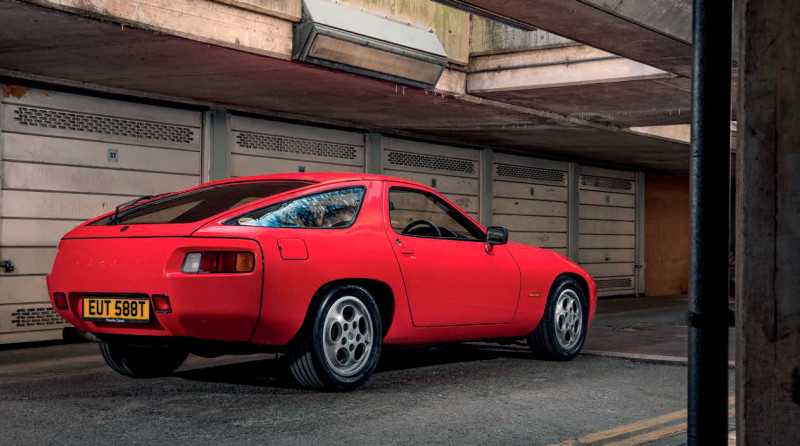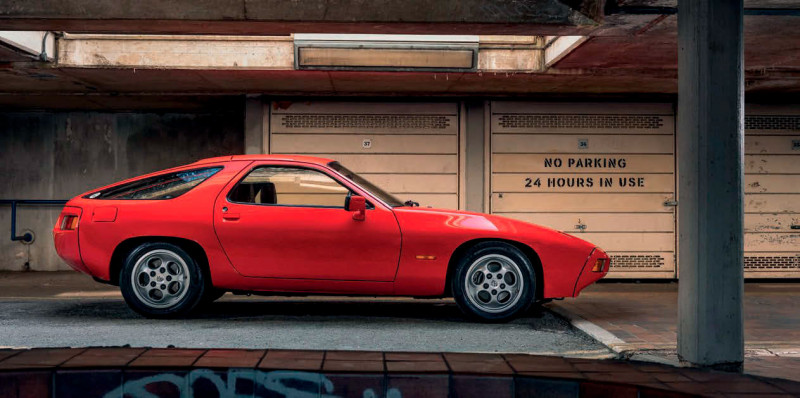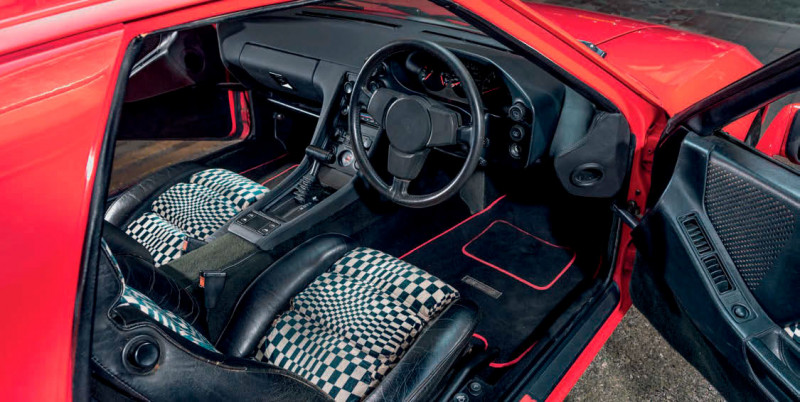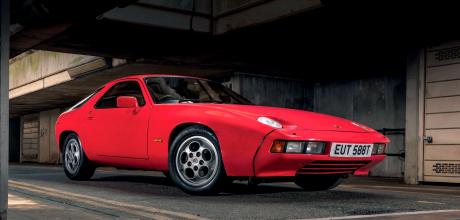1978 Porsche 928 Automatic
911 & Porsche World reader, Adam Kravitz, owns an early 928 on each side of the Atlantic. We caught up with him in London to learn more about his passion for the underappreciated ‘land shark’...
Words Dan Furr
Photography Dan Sherwood
SWIMMING WITH SHARKS
An early right-hand drive 928.

Poor man’s Aston Martin. This is how the DB6 was once viewed, an opinion partly owing to what was one of the Gaydon marque’s longest model production runs and the DB6’s resulting perceived lack of exclusivity. “I bought mine for thirteen grand in the early 2000s,” recalls Adam Kravitz. “I spent another ten bringing it up to scratch, had my fun and then sold the car for exactly the sum I paid for it, putting the money toward the purchase of a nearly new Cayenne from Porsche Centre East London.” Attitudes change as fast as you can say the word ‘regret’ — today, a DB6 will set you back six figures. A used early Cayenne? It’s probably best not to dwell. Needless to say, Adam’s Aston is at the top of his ‘cars I shouldn’t have sold’ list.
IF THE BULGING HISTORY FILE WAS ANYTHING TO GO BY, THE CAR SHOULD HAVE WANTED FOR NOTHING, BUT REALITY TOLD A DIFFERENT STORY

As an American with a British wife, he splits his time between homes in southeastern Florida and London. Consequently, his motoring history is a heady mix of Stateside muscle machines and European sports cars. “I’ve owned a 1988 Carrera 3.2 and a 2006 997 Cabriolet, but also a 1964 Buick Riviera and a 1969 right-hand drive Camaro convertible. I bought the Camaro in the UK and had it restored by a specialist in Poland, before shipping the car to Florida, where it eventually passed to a new owner. For more than two decades, I’ve been in possession of a 1965 Corvette, but my daily driver in the United States is a 1978 928 finished in gloss black over Pasha trim. The car had covered less than fifty thousand miles when my name appeared on its logbook.”

We wonder why the V8-powered Porsche holds such appeal when Adam has classic Detroit muscle at his disposal. “Cars get battered in Florida,” he explains, referencing the region’s super-hot summers. “Cabins can be like furnaces, with intense heat destroying interior trim and plastics. Additionally, the region’s high humidity can encourage rapid corrosion of metalwork. Porsche engineering and the quality of materials used during production of the brand’s cars has always been excellent, and Zuffenhausen’s decision to galvanise its products from the mid-1970s ensures cars like the 928 are able to withstand onslaught from inclement weather far more successfully than the same-age output of most other manufacturers.” This is, of course, a very practical way of looking at the 928, but Adam confesses to an emotional attachment to the sleek grand tourer. “I was an awestruck fourteen-year-old when the 928 was launched in 1977. I’d never seen anything quite like it. I was also bowled over by the fact this new Porsche was being promoted as the most expensive base model on main dealer lists, eclipsing the cost of 911 ownership.” Love at first sight, then?!
SERVE AND PROTECT
Porsche quotes 1975 as the year it introduced the galvanising process to its product line, but in truth, the company had started using galvanised parts a few years earlier. From 1970, for example, the 911’s floor pan and wheel arches were made from galvanised steel and, over the next few years, more parts were treated until, from the end of 1975, Porsche moved to make the entire 911 from fully galvanised steel. German industrial engineering conglomerate, Thyssen (now Thyssenkrupp), is credited with producing the zinc-coated steel for Porsche production.

Thyssen dipped steel sheets into molten zinc at 500°C, varying the thickness of the coating from ten microns (a hundredth of a millimetre) to fifty microns, depending on the component the sheet steel was to be made into and how exposed to the elements or susceptible to rust it was likely to be. Porsche had to experiment with these coated sheets of metal to ensure they could be formed into final body parts without losing their protective coating. It was also necessary to rethink how the components were welded together, not least because toxic gases are emitted during the process. All this cost Porsche a relative fortune, adding an estimated £50 to the manufacturing cost of each car, equivalent to £350 today. Galvanising also added some ten kilograms to the overall mass of each finished vehicle. Even so, it gave Porsche buyers confidence in the quality of their purchase, bolstered by an industry-leading warranty (introduced in 1976) valid for six years against rust of the core chassis. This promise was upped to seven years in 1981, following an extension of the galvanised material to the 911’s roof. In 1986, Porsche raised its anti-perforation warranty period to ten years.
Sadly, those warranties have long expired and, while seeking out a vehicle that was originally zinc-treated is a wise move by any would-be classic Porsche buyer, finding such a car is no get-out-of-jail card. How much the zinc coating will have deteriorated will depend on the ambient conditions the car was subjected to throughout its life. Was it left outside for long periods? Was it parked under trees where lichen and other nasties could attack the bodywork? Did it inhabit in an area where acid rain is particularly bad or where roads are regularly treated with salt? All of these things will have contributed to breaking down the zinc coating and, while there’s still some protection if the steel underneath is exposed to the elements, it’s only a matter of time before it too begins to corrode.
Thankfully, the bodywork of Adam’s 928 was in excellent condition, though the car required spend in other areas. “I pumped ten grand into restoring tired aspects of the Pascha interior and electrics, as well as sorting a few mechanical gripes. The car is now what I refer to as a ‘time capsule’ Porsche, exactly as it left the assembly line. I use it every day for commuting, plus trips out with my local Porsche Club of America group, where I’m almost always the only 928 driver in attendance. It’s a great car and I’m looking forward to many more adventures with it.”
Parting with his Porsche when flying to the UK in order to spend time with the British side of his family was something of a wrench, which is why Adam’s ears pricked up when, over dinner in London, a friend was scouting Auto Trader classifieds and announced the availability of the Guards Red 928 you see on these pages. A rare single-mirror variant trimmed in that oh-so-seventies Pasha fabric, the car was manufactured in August 1978 prior to being sold by Porsche dealer, Glenn Henderson, at a list price of £19,499 on 8th October that year. Long-term ownership characterizes the history file, which documents time the car spent in Scotland, where it became a display piece in an independent motor trader’s showroom window.
“This 928 was very well cared for by previous owners,” Adam continues. “With the exception of the exhaust silencers, it has remained in factory specification and was treated to a respray in the late 2000s.
More recently, it was displayed at Porsche Centre Hatfield, where it spent time wowing the dealership’s customers on the site’s Porsche Classic Partner Centre stand. Thereafter, however, it was sold at auction and, come late 2018, ended up at a van sales dealership, where appropriate care and attention wasn’t observed.
Believe me, the worst thing you can do to a 928 is leave it standing for long periods.” On the face of it, and if the bulging history file was anything to go by, the car should have wanted for nothing, but reality told a different story — essentially, Adam bought this Porsche as a nonrunner. “I didn’t even get to take it for a test drive,” he laughs. “I turned up to view the car and was surprised at how much work it needed, a consequence of it being left stationary for the best part of two years. The transmission had dumped its fluid, the interior was worn and the car was showing general signs of neglect, but I reasoned I’d stepped in before any serious problems could set in and negotiated a price reflecting the condition I was presented with, which wasn’t in keeping with the description outlined on the Auto Trader listing.”
COLD TREATMENT
The inspection took place at the beginning of autumn 2021. The Kravitz clan’s return to the United States was imminent, but the family was scheduled to spend Christmas with relatives in London. Adam therefore arranged for the car to be collected and carried to Paul Anderson (known in the 928 community as Doctor A) at Stroud-based model servicing and repair centre, 928 Specialists, with an instruction to get the impotent GT running in time for fun on the road in winter.
“I was reassured by Paul’s opinion I’d bought a good car at a good price, but I didn’t anticipate quite how many wrongs he’d need to right,” Adam sighs. “By the time the necessary work was done, I’d ended up spending as much as I paid for the car.” As was the case with his black 928, various aspects of the radiant red Porsche were in need of attention, not least the air-conditioning system and the rear hatch, which was letting in water.
As a precautionary measure, the top end of the engine was also given an overhaul, but despite Paul’s work in resurrecting the car in time for Christmas, personal circumstances meant Adam wasn’t able to return to the UK until March this year, meaning the first time he got behind the wheel was in the lead-up to our photo shoot.
To look at, this is truly a gorgeous 928, but we wonder how the drive compares to that of Adam’s same-year black example back in the USA. “The European car feels noticeably faster,” he tells us. When it comes to Porsches of this vintage, there can be differences in performance based on the condition of engine components alone, even when the cars were built to identical specification and have covered similar mileage, but in the case of 4.5-litre 928s destined for the North American market, smog-reducing kit necessitated by strict emissions legislation dropped power by almost twenty ponies.
“I’ve struggled with the single door mirror, a rare feature, but one proving challenging to someone used to driving on the other side of the road,” Adam smiles. “I certainly don’t know how I’d manage driving this car if I ever decided to import it to Florida, where European-specification classic and modern-classic cars are popular because of their greater power output when compared to the same models originally supplied to the United States domestic sales market. Remaining sympathetic to originality, I don’t like the idea of installing a passenger door mirror, but I don’t see any other option for driving this 928 safely in America.”
For the time being, he’s committed to getting the best out of the car in London, where we’ve taken the pictures you see on these pages. Lady Luck, however, has decided to spoil the party.
STOP THE CLOCKS
Considering this is one of the first opportunities Adam has had to drive his new Porsche, possibly the oldest surviving right-hand drive 928 on UK roads, we were dismayed to hear him register concern the clutch was slipping during our action shots. Reasoning he needed to return the car to Stroud without delay, he set off in the direction of 928 Specialists, only to grind to a halt a couple of miles into the journey. The damage was greater than anticipated — since our photo shoot, the car has been treated to a replacement gearbox. Adam remains philosophical, despite his frustration at the absence of seat time. “I like to put miles on my cars. Doing so is the only way to discover what’s needed to return them to the ‘time capsule’ condition I enjoy so much.”
With the mechanicals sorted, he’s now set to turn his attention to the 928’s cosmetic condition. Fresh paint is on the cards, as is a retrim of the somewhat tired interior, plus the appointment of a new headlining and windscreen. “I recently replaced the glass and seals on my Florida-residing 928. The car’s cabin is now super-quiet. It’s like driving a Lincoln Continental!” Returning to the UK in July, he’s looking forward to finally adding plenty of miles to the red V8. Well, he was looking forward to many smiles and miles — just as this magazine was going to press, Adam broke his leg in two places. Drat. At least work bringing this rare red 928 back to its best can continue, even if its master has to look on in anticipation of the day man and machine can finally hit the road without cause for complaint. We have every faith it’ll be worth the wait.
Above and below The 928 is the only sports car to have won the European Car of the Year award.
Above and below Adam intends to restore the car’s interior, which is equipped with Porsche’s classic Pasha fabric. Above Single door mirror is a rare early feature, though not entirely practical in today’s traffic. Above Collectors are increasingly looking for early 928s, which deliver the purest form of the model’s futuristic design.
WITH THE MECHANICALS SORTED, HE’S NOW SET TO TURN HIS ATTENTION TO THE 928’S COSMETIC CONDITION


